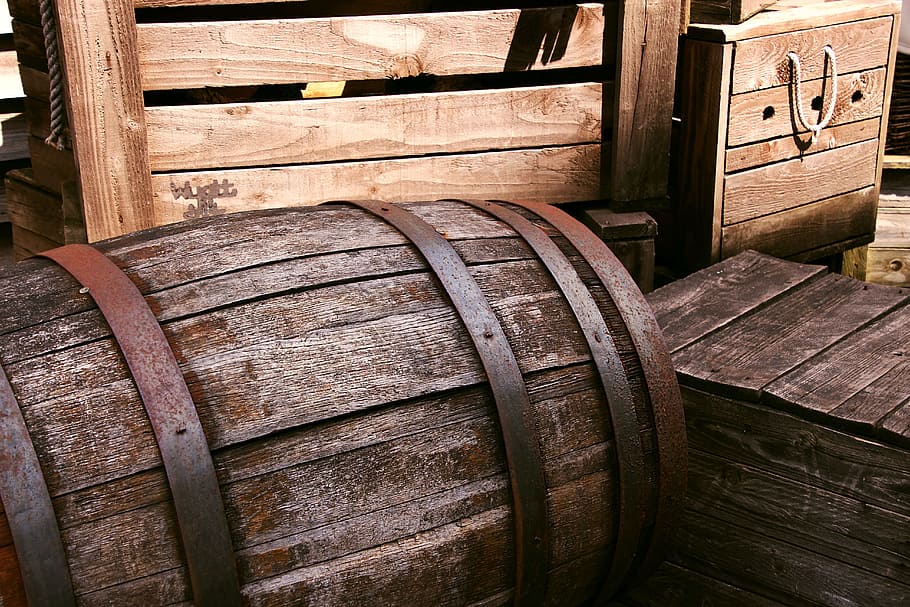
Aging whiskey is a process that involves storing the distilled spirit in oak barrels for a certain period of time. During this time, the whiskey takes on the flavors and characteristics of the wood, resulting in a smooth, complex taste. While most whiskey is aged in commercial distilleries, some enthusiasts wonder if they can age whiskey at home. The short answer is yes, it is possible to age whiskey at home, but it requires some effort and patience.
There are several methods for aging whiskey at home, including using wood chips and staves, small oak barrels, or charred strips. Each method has its own advantages and disadvantages, and the choice depends on personal preference and the desired outcome.
Table of Contents
Understanding Whiskey Aging
Whiskey aging is a complex process that involves a combination of chemical reactions and physical changes. During the aging process, the whiskey interacts with the wood of the barrel, which imparts flavor, aroma, and color to the spirit.
The type of wood used in the barrel plays a crucial role in determining the final flavor profile of the whiskey. Most whiskey barrels are made from oak, which is a porous wood that allows the whiskey to breathe and absorb the flavors and aromas of the wood.
The aging process also involves the evaporation of the whiskey, which is known as the “angel’s share.” This loss of volume concentrates the flavor and aroma of the remaining whiskey and contributes to the smoothness of the final product.
The length of time that whiskey is aged can vary depending on the type of whiskey and the desired flavor profile. For example, bourbon whiskey must be aged for a minimum of two years in new, charred oak barrels. Scotch whisky, on the other hand, is typically aged for a minimum of three years in used oak barrels.
Legality of Aging Whiskey at Home
Aging whiskey at home is a popular hobby for whiskey enthusiasts. However, it is important to understand the legality of aging whiskey at home before embarking on this endeavor.
In the United States, it is legal to age whiskey at home as long as it is for personal consumption and not for sale. The Federal Alcohol Administration Act (FAA) allows individuals to produce wine and beer at home for personal use, and this law was amended in 1978 to include the production of distilled spirits for personal consumption.
However, it is important to note that the FAA does not allow individuals to sell or distribute their homemade whiskey. If an individual wants to sell their whiskey, they must obtain the appropriate licenses and permits from the Alcohol and Tobacco Tax and Trade Bureau (TTB).
It is also important to abide by state and local laws regarding the production and consumption of alcohol. Some states have restrictions on the amount of alcohol an individual can produce for personal use, and some states prohibit the production of distilled spirits altogether.
As long as an individual is producing whiskey for personal consumption and abiding by federal, state, and local laws, aging whiskey at home is legal in the United States.
Necessary Equipment for Home Aging
Aging whiskey at home requires some necessary equipment to ensure the process is successful. Here are some of the essential supplies:
1. Oak Barrels
Oak barrels are the most traditional and effective way to age whiskey at home. They help to impart flavor, aroma, and color to the whiskey. Oak barrels come in different sizes and shapes, and you can choose the one that suits your needs. The most common sizes are 1 liter, 2 liters, and 5 liters. You can purchase oak barrels from various online stores or specialty shops.
2. Wooden Staves
If you don’t have the space or budget for an oak barrel, you can use wooden staves instead. Wooden staves are small pieces of wood that you can add to your whiskey bottle or jar to age the whiskey. They come in different types of wood, including oak, cherry, and maple. You can purchase wooden staves from online stores or specialty shops.
3. Charred Strips
Charred strips are another option for aging whiskey at home. They are small pieces of wood that have been charred or burned to impart flavor and aroma to the whiskey. You can add them to your whiskey bottle or jar to age the whiskey. Charred strips come in different types of wood, including oak, cherry, and maple. You can purchase charred strips from online stores or specialty shops.
4. Mason Jars
Mason jars are a great option for aging whiskey at home, especially if you’re using wooden staves or charred strips. They are affordable, easy to find, and come in different sizes. Mason jars are also airtight, which helps to prevent evaporation and maintain the flavor of the whiskey.
5. Funnel
A funnel is a necessary tool when aging whiskey at home. It helps to transfer the whiskey from one container to another without spilling or wasting any of it. You can purchase a funnel from any kitchen supply store or online retailer.
Choosing the Right Whiskey
When it comes to aging whiskey at home, choosing the right whiskey is crucial. The type of whiskey you choose will impact the final flavor of the aged whiskey.
Types of Whiskey
There are several types of whiskey to choose from, including bourbon, rye, scotch, and Irish whiskey. Each type has its own unique flavor profile and aging requirements.
Bourbon is made from at least 51% corn and aged in new, charred oak barrels. It has a sweet and smooth flavor profile with notes of vanilla and caramel.
Rye whiskey is made from at least 51% rye and aged in new, charred oak barrels. It has a spicy and bold flavor profile with notes of pepper and cinnamon.
Scotch is made from malted barley and aged in used oak barrels. It has a smoky and peaty flavor profile with notes of heather and honey.
Irish whiskey is made from a blend of malted and unmalted barley and aged in used oak barrels. It has a smooth and mellow flavor profile with notes of honey and vanilla.
Choosing the Right Whiskey for Aging
When choosing a whiskey for aging, it’s important to consider the flavor profile and aging requirements of the whiskey. Bourbon and rye whiskey are popular choices for aging at home because they are aged in new, charred oak barrels, which makes them more receptive to the flavors of the oak.
It’s also important to choose a whiskey that is of good quality. A low-quality whiskey will not improve with aging and may even become worse.
The Aging Process
Aging whiskey is a crucial step in the production process that gives it its signature flavor and color. The aging process involves storing whiskey in oak barrels for a specific period. During this time, the whiskey interacts with the wood, which imparts flavors and aromas to the spirit.
The length of time the whiskey spends in the barrel is a critical factor in determining its quality. Generally, the longer the aging process, the smoother and more complex the whiskey becomes. However, there is no fixed rule for how long whiskey should age. Some distillers age their whiskey for a few years, while others age it for several decades.
The aging process is affected by several factors. The type of oak used for the barrel, the size of the barrel, and the climate where the barrel is stored all play a role in the final product’s flavor profile. For example, whiskey aged in a smaller barrel will have a more intense flavor than whiskey aged in a larger barrel.
During the aging process, the whiskey also undergoes several chemical reactions. The wood in the barrel contains natural sugars and compounds that are released into the whiskey over time. This process gives the whiskey its characteristic vanilla, caramel, and butterscotch flavors.
Optimal Conditions for Aging
When aging whiskey at home, it is important to create optimal conditions for the process to be successful. Here are some factors to consider:
Temperature
Whiskey aging is affected by temperature, and it is important to maintain a consistent temperature throughout the aging process. The ideal temperature range for aging whiskey is between 60°F and 65°F. Fluctuations in temperature can cause the whiskey to expand and contract, which can affect the flavor and aroma of the whiskey.
Humidity
Humidity is another important factor to consider when aging whiskey. The ideal humidity range for whiskey aging is between 60% and 70%. If the humidity is too low, the whiskey can evaporate, and if it is too high, the wood can absorb too much moisture, which can affect the flavor and aroma of the whiskey.
Lighting
Whiskey should be aged in a dark place, away from direct sunlight. Exposure to sunlight can cause the whiskey to oxidize, which can affect the flavor and aroma of the whiskey.
Airflow
Whiskey should be aged in a place with good airflow. This will allow the whiskey to breathe and develop its flavor and aroma. However, too much airflow can cause the whiskey to evaporate too quickly, so it is important to strike a balance.
Storage Containers
The type of container used for aging whiskey can also affect the flavor and aroma of the whiskey. Oak barrels are the traditional choice for aging whiskey, but they can be expensive and difficult to obtain. Wooden staves or charred strips can be used as an alternative, but they may not provide the same depth of flavor as oak barrels. Glass containers can also be used for aging whiskey, but they should be airtight to prevent evaporation.
Potential Risks and Challenges
Aging whiskey at home can be an exciting and rewarding experience, but it’s not without its potential risks and challenges. Here are a few things to keep in mind:
Contamination
One of the biggest risks when aging whiskey at home is contamination. If your equipment or workspace isn’t properly sanitized, bacteria or other microorganisms can easily get into your whiskey and spoil it. This can result in off-flavors or even make your whiskey unsafe to drink.
To avoid contamination, it’s important to thoroughly clean and sanitize all of your equipment before and after each use. This includes your aging vessel, any tools or utensils you use, and your workspace.
Inconsistent Results
Another challenge with aging whiskey at home is achieving consistent results. Unlike commercial distilleries, which have precise control over factors like temperature, humidity, and air flow, home aging is subject to more variability.
Factors like the temperature and humidity of your aging environment, the size and shape of your aging vessel, and the type of wood you use can all affect the final flavor of your whiskey. This means that even if you follow the same aging process every time, you may still end up with slightly different results.
Time and Patience
Aging whiskey at home also requires a significant amount of time and patience. Unlike other home brewing or distilling projects, which can be completed in a matter of days or weeks, aging whiskey can take months or even years.
This means that you’ll need to be patient and willing to wait for your whiskey to reach its full potential. It also means that you’ll need to be able to store your aging vessel in a cool, dark place for an extended period of time.
Legal Considerations
Finally, it’s important to note that there may be legal considerations when aging whiskey at home. In some jurisdictions, it may be illegal to distill or age whiskey without a permit or license.
Before you start aging whiskey at home, be sure to research the laws in your area and make sure you’re in compliance. Failure to do so could result in fines or other legal consequences.
Tasting and Evaluating
Once your whiskey has aged to your desired taste, it’s time to evaluate the final product. Whiskey tasting is a subjective experience, and everyone’s palate is different. However, there are some general guidelines to follow when evaluating the quality of your aged whiskey.
First, pour a small amount of whiskey into a glass and give it a swirl to release the aromas. Take a deep sniff and note the aroma. The aroma of a whiskey can reveal a lot about its flavor profile.
Next, take a sip of the whiskey and let it sit on your tongue for a few seconds. Swish it around in your mouth to fully coat your taste buds. Note the flavor profile, including any notes of sweetness, bitterness, or spiciness.
After swallowing, note the finish of the whiskey. A long finish indicates a high-quality whiskey, while a short finish may indicate a lower quality product.
It’s also important to evaluate the mouthfeel of the whiskey. Is it smooth and silky or harsh and abrasive? The mouthfeel can reveal a lot about the aging process and the quality of the whiskey.
Frequently Asked Questions
What are the best types of wood chips to use for aging whiskey at home?
The best types of wood chips to use for aging whiskey at home are American white oak, French oak, and cherry wood. These woods are commonly used in the whiskey industry and are known to impart the best flavors to the whiskey.
What is the best whiskey to age at home?
The best whiskey to age at home is a high-quality, unflavored whiskey. It is recommended to choose a whiskey with a high alcohol content (around 55-62% ABV) for optimal aging.
How long does it take to age whiskey in a mini barrel?
The time it takes to age whiskey in a mini barrel depends on a variety of factors, including the size of the barrel, the type of wood, and the desired flavor profile. On average, it takes around 2-6 months to age whiskey in a mini barrel. However, it is important to taste the whiskey regularly to ensure it has reached the desired flavor profile.
Where can I find oak barrels for sale to age whiskey at home?
Oak barrels for aging whiskey at home can be found at specialty stores, online retailers, and even some homebrew supply stores. It is important to ensure that the barrel is made of high-quality oak and has been properly charred before use.
What are the steps to barrel aging whiskey at home?
The steps to barrel aging whiskey at home include cleaning and sanitizing the barrel, filling the barrel with high-quality unflavored whiskey, storing the barrel in a cool, dark place, and regularly tasting the whiskey to ensure it has reached the desired flavor profile.
Can you use a whiskey aging kit to age other spirits?
Yes, a whiskey aging kit can be used to age other spirits, such as rum, tequila, or even wine. However, it is important to note that the flavor profile of the final product will be influenced by the type of wood used and the original flavor of the spirit being aged.
Conclusion
In conclusion, aging whiskey at home is possible and can be a fun and rewarding experience for whiskey enthusiasts. While it may not be as easy as simply pouring whiskey into a barrel and waiting, with the right tools and techniques, home-aged whiskey can rival even the finest aged whiskeys on the market.
There are several methods for aging whiskey at home, including barrel aging, wooden staves aging, and charred strips aging. Each method has its own pros and cons, and the choice ultimately comes down to personal preference and available resources.
It is important to note that aging whiskey at home requires patience and attention to detail. The aging process can take several weeks or even months, and it is essential to monitor the whiskey regularly to ensure that it is aging properly.
With the right approach, aging whiskey at home can be a fun and rewarding experience that allows whiskey enthusiasts to create their own unique flavor profiles and experiment with different aging techniques.
Related Posts
If you’re interested in learning more about whiskey, there are plenty of resources available online. Here are a few related posts to help you expand your knowledge:
- From Beginner to Connoisseur #2 : A Roadmap of American Whiskey
- Rum vs Whiskey: What’s the Difference?
- Reviewing the brand new Slane Irish Whiskey
- 3 New Irish Whiskey Distilleries to Watch Out
- What is Moonshine Whiskey: A Guide to the Illicit Spirit



